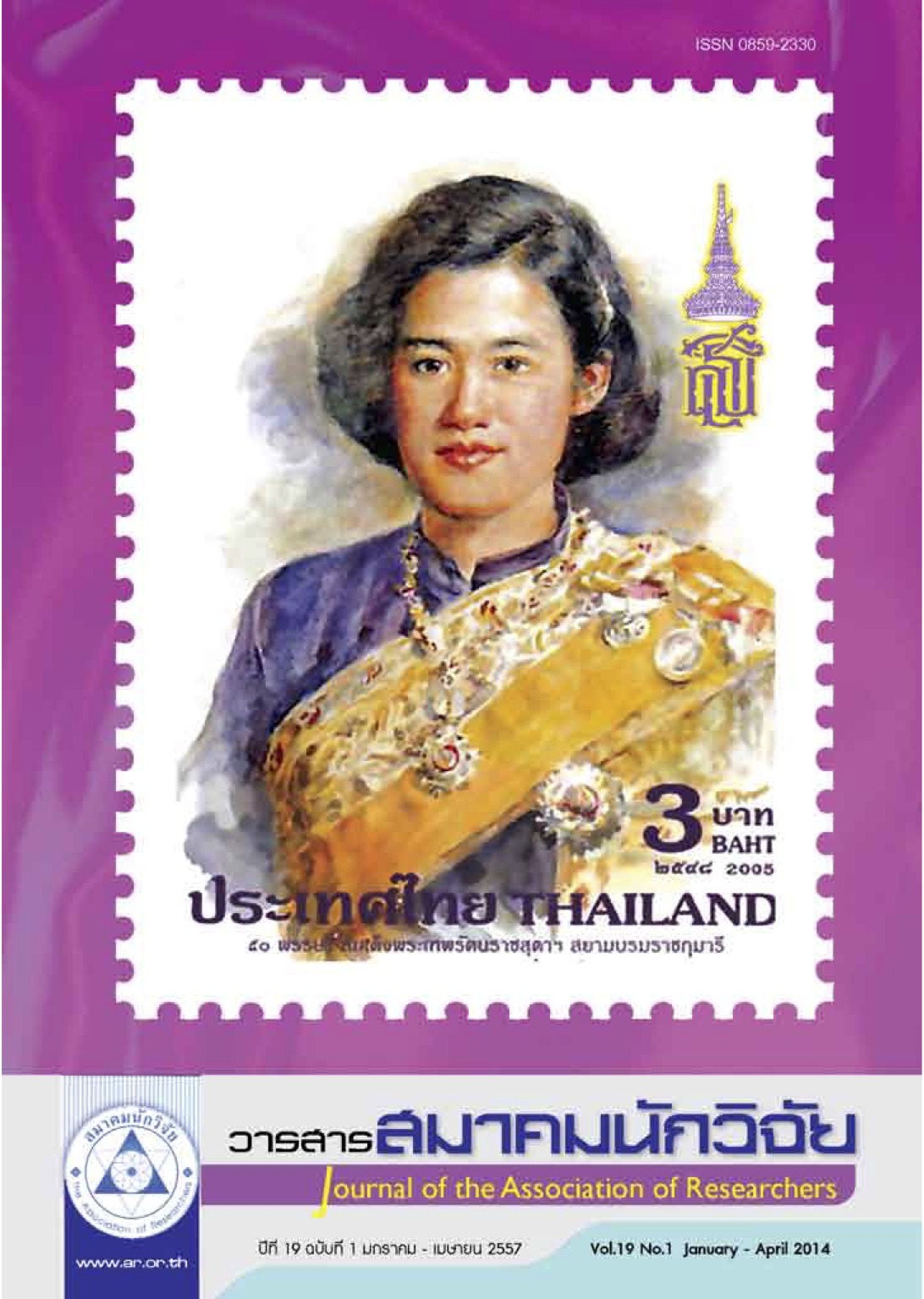A STRUCTURAL EQUATION MODEL OF FACTORS INFLUENCING PARTICIPATIVE BEHAVIORS IN COMMUNITY ACTIVITY OF ELDERS IN JATUJAK DISTRICT, BANGKOK METROPOLIS
Main Article Content
Abstract
The purpose of this research was to test and develop the Structural Equation Model of Factors Influencing Participative Behaviors in Community Activity.The sample consisted of 500 elders, 264 male and 236 female, in Jatujak District, Bangkok Metropolis, randomly selected by the stratified sampling. 11 sets of reliable and valid questionnaires were used to collect data. Their alpha coefficients ranged from 0.819 to 0.947. The structural equation model was tested and developed. The results were as follows: The developed structural equation model was well consistent with the empirical data by the goodness of fit indices of χ2 = 1492.25, df = 454, p = 0.000, χ2/df = 3.29, RMSEA = 0.068, SRMR = 0.075, NNFI = 0.97 and CFI = 0.98, statistically significant at χ=0.05. The findings were revealed that: 1) Participation in Community Activity was directly influenced by the highest effecting variable, Attitude to Community Activity followed by Perceived Strength Community. 2) Perceived Mental Health was directly influenced by the highest effecting variable, Optimism followed by Perceived Physical Health and Participation in Community Activity respectively. 3) Perceived Social Acceptance was directly influenced by the highest effecting variable, Participation in Community Activity followed by Perceived Mental Health. 4) Attitude to Community Activity was directly influenced by the highest effecting variable, Perceived Strength Community followed by Subjective Norms. 5) Perceived Self-Efficacy was directly influenced by the highest effecting variable, Family Supports followed by Beliefs. 6) Perceived Physical Health was directly influenced by the highest positive and effecting variable, Perceived Self-Efficacy followed by Optimism.
Article Details
บทความที่ปรากฏในวารสารนี้ เป็นความรับผิดชอบของผู้เขียน ซึ่งสมาคมนักวิจัยไม่จำเป็นต้องเห็นด้วยเสมอไป การนำเสนอผลงานวิจัยและบทความในวารสารนี้ไปเผยแพร่สามารถกระทำได้ โดยระบุแหล่งอ้างอิงจาก "วารสารสมาคมนักวิจัย"
References
จิราพร เกศพิชญาวัฒนา, จันทร์เพ็ญ แสงเทียนฉาย, ยุพิน อังสุโรจน์ และเบนิท อิงกาซอล-เดตัน. (2543). “ความ ผาสุกทางใจของผู้สูงอายุไทย : กรณีศึกษาเชิงคุณภาพ”. วารสารพฤฒาวิทยาและเวชศาสตร์ผู้สูงอายุ, 1(3), 21-28.
เฉลียว บุรีภักดี และคณะ. (2545). ชุดวิชาการวิจัยชุมชน : Community Research Study. กรุงเทพฯ : เอส. อาร์. พริ้นติ้ง แมสโปรดักส์. บรรลุ ศิริพานิช. (2549). คู่มือผู้สูงอายุฉบับสมบูรณ์. กรงุเทพฯ :
สำนักพิมพ์หมอชาวบ้าน. ปาริชาติ วลัยเสถียร และคณะ. (2543). กระบวนการและเทคนิคการทำงานของนักพัฒนา. กรุงเทพฯ : เอดสินั เพรสโปรดกัท.์
พร้อมจิตร ห่อนบุญเหิม. (2550). ความสัมพันธ์ระหว่างรุ่นวัยและความอยู่ดีมีสุขของผู้สูงอายุ. วิทยานิพนธ ์ปริญญาศิลปศาสตรดุษฎีบัณฑิต สาขาวิชาพัฒนศาสตร์ บัณฑิตวิทยาลัย มหาวิทยาลัยขอนแก่น. เลม่ 120 ตอนท ี่130 ก : 1 - 8. 1 ธันวาคม 2546.
พินทุสร ปัตยะกร และคณะ. (2553). ปัจจัยที่มีผลต่อความพึงพอใจในชีวิตของหญิงไทย สูงอายุที่ป่วยเป็น โรคขอ้เขา่เสอื่ม. ดษุฎนีพินธ ์คณะแพทยศาสตร ์โรงพยาบาลรามาธบิด ีมหาวทิยาลยัมหดิล.
ศิริวรรณ ศิริบุญ และมาลิน ี วงษ์สิทธิ์. (2541). “การมีส่วนร่วมในชุมชน”.สถาบันสถาบันประชากรศาสตร์, จุฬาลงกรณ์มหาวิทยาลัย. เอกสารสถาบันหมายเลข 265/41 หน้า 44 และหน้า 58
สำนักงานสถิติแห่งชาติ. (2553). แนวโน้มผู้สูงอายุในประเทศไทย.กรุงเทพฯ:สำนักงานสถิติแห่งชาต ิกระทรวงเทคโนโลยสีารสนเทศและการสอื่สาร.
สุภมาส อังศุโชติ. (2552). สถิติวิเคราะห์สำหรับการวิจัยทางสังคมศาสตร์และพฤติกรรมศาสตร์: เทคนิคการใช้ โปรแกรม. LISREL, กรุงเทพฯ:โรงพิมพ์เจริญมั่นคงการพิมพ์.
อาภากร ชัยสุริยา. (2543). ปัจจัยที่มีอิทธิพลต่อความพอใจของผู้สูงอายุในสถานสงเคราะห์คนชราบ้านบางแค. วิทยานิพนธ์ ศิลปศาสตรมหาบัณฑิต.สังคมวิทยาประยุกต์ บัณฑิตวิทยาลัยมหาวิทยาลัยเกษตรศาสตร์.
อภิญญา กังสนารักษ์. (2544). รูปแบบการบริหารแบบมีส่วนร่วมในองค์กรที่มีประสิทธิผลระดับคณะของสถาบัน อุดมศึกษา. กรุงเทพฯ : จุฬาลงกรณ์มหาวิทยาลัย.
Joreskog, K. G., & Sorbom, D. (1993). LISREL 8 : Structural Equation Modeling with the SIMPLIS Command Language. Chicago : Scientific Software International.
Heather, N. R., Scheier, M.F., & Greenhouse, J.B. (2009). Optimism and Physical Health: A Meta – analytic Review. Ann BehavMed, 37(3), 239 - 256. 157Vol
Hu, L.T., & Blentler, P. M. (1999). “Cutoff criteria for fit indexes in covariance structure analysis: Coventional criteria versus new alternatives”. Structural Equation Modelling, 6(1), 1-55.
Kline, R. B. (2005). Principle and Practice of Structural Equation Modelling . 2nd edition. New York : The Guildford Press.
Magnus, G. (2009). The Age of Aging: How demographics are changing the global economy and our world, Singapore: John Wiley & Sons.
Mok, B. H. (2004). “Self - help group participation and empowerment in Hong- Kong”. Journal of sociology and social welfare, 31(3), 153 - 168.
Lau, A., Chi, I., & McKenna, K., (1998). Self-perceived quality of life of Chinese elderly people in HongKong. Occupational Therapy International, 5(2), 118-139.
Rabiega, J., & Cannon, B. J. (2008). The relationship of Optimism with psychological and Physical well-being. Scranton : Marywood University Press
Schumacker, R. E., & Lomax, R. G. (2004). A beginner’s guide to structural equation modelling. Second edition. Mahwah, NJ : Lawrence Erlbaum Associates.
Stevens, J. P. (2002). Applied Multivariate Statistics for the Social Sciences. 4th Editon. Mahwah, New Jersey : Lawrence Erlbaum Associates,.
Yamane, T. (1973). Statistics : An Introductory Analysis. New York : Harper &Row.


